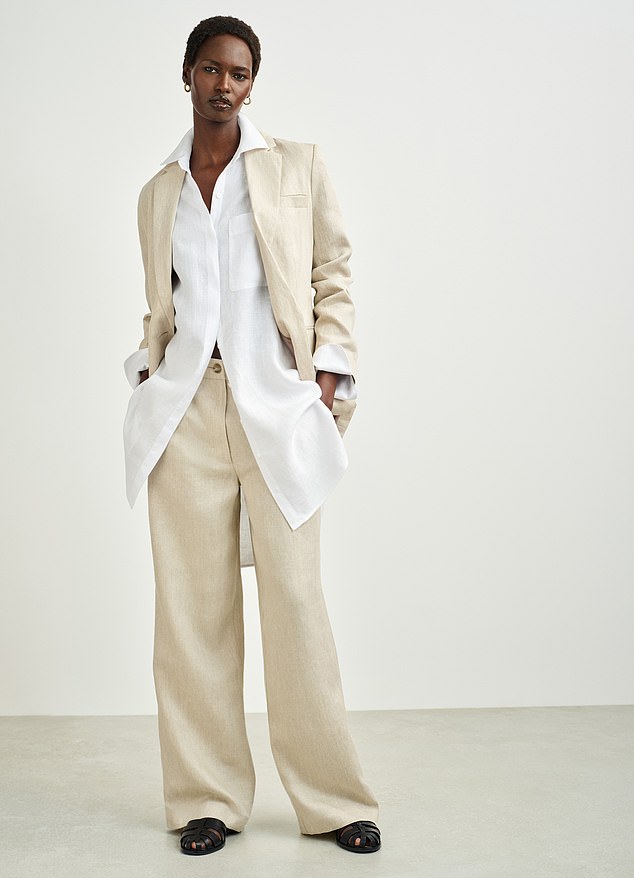Experts reveal why wearing less clothes will NOT cool you down in the heat – and explain what to wear instead
In the summer heat, you may be tempted to strip down completely.
But textile scientists and stylists say it might be better to cover up.
When you wear a tank top and shorts, you expose your skin to more intense rays from the sun. This can increase your risk of skin cancer by cooling your skin.
However, experts stress that the key to beating the heat lies in the fabric and that choosing the right material and color of clothing is paramount when it comes to staying cool during a summer heatwave.
Larissa Marie Shepherd, a professor who studies fibers and fabrics down to the molecular level, said, “Not wearing anything is not good. I would not recommend it.”
Scientists have discovered that wearing fabrics and shapes that work with our body’s natural cooling system (absorbing sweat and releasing body heat) can help keep you cool all summer long.

Wearing less won’t help you stay cooler, experts say. They recommend wearing long-sleeved, loose-fitting clothing in light colors to really beat the heat.
Studies of indigenous Bedouin tribes in the Middle East found that their traditional, loose-fitting robes kept wearers cooler than participants wearing uniforms that left some of the skin exposed.
That’s because experts say keeping yourself cool has less to do with tank tops and shorts and more to do with air circulation and moisture on your skin.
First, the airflow over your skin pushes the heat away – just like sitting in front of a fan on a hot day cools you down. In general, the more air a fabric lets through, the cooler you feel.
Then, the better a garment helps to remove moisture from your skin, the cooler you will feel. The faster the water evaporates from the fabric, the more heat there is in the air and the less you feel it.
Scientists say linen is king when it comes to summer clothing because it ticks both boxes. The gaps between the woven fibers of this fabric allow air to pass through, making it easier for sweat to evaporate from your skin and cooling you down.
Fabrics such as wool, on the other hand, which are packed closely together, retain heat.
Considering these two factors, experts say you should do the following: Look at the label of the garment and find out what it is made of.
shepherd told the Washington Post: ‘You don’t want something that clings to your body. You want something that’s light and airy.
“If I’m just hanging out, I’d probably recommend a loose-fitting long-sleeved linen shirt.”

Linen is a wide, woven texture that allows some air to circulate, wicking away some moisture and can help you feel cooler. However, some stylists, like Ms. Newberger, don’t recommend it because it wrinkles easily.
The natural fibers breathe best, draw moisture away from the skin and allow it to evaporate easily.
While stylists agree that linen keeps you cool, they warn of the fashion faux pas that comes with linen: it wrinkles easily. So when temperatures rise, you may have to choose between staying cool and looking cute.
However, the drawbacks of linen haven’t stopped Hollywood’s chicest celebrities from wearing the material when they’re out and about in the summer heat.
Jennifer Lawrence, 33, was photographed last month running errands in what appeared to be a long-sleeved white linen shirt and slacks IN New York, where temperatures soared to over 30 degrees.
The natural, lightweight fabric is made from flax plants and is the lightest option for summer, stylist Miranda Holder previously told DailyMail.com.
“Linen is the first choice when it comes to midsummer fashion,” she said.
For those looking to stay cool and fresh, stylist Heather Newberger recommends her clients fabrics like lyocell and pleated, made from wood chips and cotton, respectively.
She said these materials stay as cool as linen, allowing air to pass through and transfer heat away from your skin, but they don’t wrinkle.
Once you have chosen a material, you should pay close attention to the fit of your clothing.
Wearing tight clothing traps heat and moisture, making you feel hot and sweaty. Choosing baggy pants and loose-fitting shirts will keep you cooler because more air can circulate over your skin.
Fortunately, Ms. Newberger said, this is in line with current fashion trends: “We’re in a great space right now where oversized is king. The coolest looks out there are often things that are oversized.”
She recommends ‘an oversized shirt made from organic fibers and wide-leg pants that allow air to flow through you and also provide protection from the sun.’
Maxi dresses are also a good choice.
Finally, when dressing for the heat, you should consider the color of your clothing.
Fabrics with dark pigments, such as black, grey or navy, absorb more heat than lighter colours, such as cream and pastel shades. This can make you feel warmer.
Plus, some colors, like red, can make you feel warmer psychologically, stylist Denise Caldwell told the Washington Post.
Instead, she recommended white, nudes or light pastel shades, saying that everyone within these camps should be able to find a color that flatters them without making them attractive.
